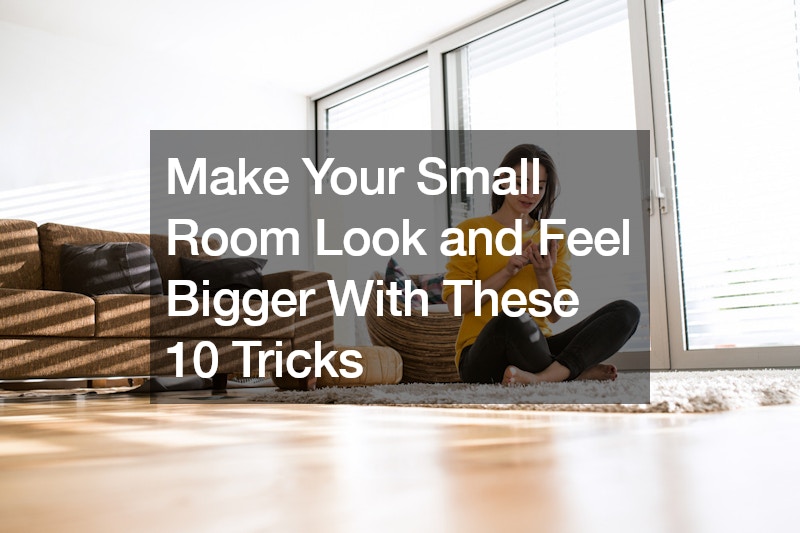

Small rooms often convey a sense of confinement, but through thoughtful design decisions, you can create the perception of spaciousness and turn your space into a more welcoming and expansive area. Whether you’re dealing with a tiny apartment, a cozy bedroom, or even a compact office space, these ten tricks will help you maximize every square inch and make your room look and feel bigger.
1. Lighter, Cooler Colors
One of the simplest yet most effective ways to open up a small room is by using lighter, cooler colors on your walls. Shades of white, soft grays, and light blues can significantly enhance the sense of space by reflecting more light and creating an airy atmosphere.
These colors not only brighten up the room but also visually expand it, making it feel less confined.
2. Declutter Your Space
Clutter can quickly overwhelm a small room, making it appear even smaller than it is. Take the time to declutter by removing unnecessary items and organizing what remains. Simplify your décor to essentials that serve both functional and aesthetic purposes. This minimalist approach not only frees up physical space but also creates a cleaner, more spacious look.
3. Utilize Mirrors
Mirrors are a magical tool for making small rooms feel larger. Their ability to reflect light and create visual depth instantly doubles the perceived size of a room. Strategically placing mirrors can maximize their effect and transform the space.
Mirrors placed across from windows bounce natural light around the room, making it appear brighter and more spacious. You can also incorporate mirrors into a gallery wall or group them together to add visual interest while expanding the perceived dimensions of the room. Moreover, choose larger mirrors to maximize their reflective surface area and impact on the room. A large mirror can effectively open up a small space by reflecting more light and creating a broader sense of openness.
4. Optimize Drapery Placement
Adjusting your drapery can also make a significant difference in how spacious your room feels. Hang curtains closer to the ceiling rather than just above the window frame. This elongates the walls and draws the eye upward, creating the illusion of higher ceilings and a larger room overall.
5. Choose Appropriate Furniture Scale
When furnishing a small room, it’s crucial to select pieces that are proportionate to the space. Opt for smaller-scale furniture that fits comfortably without overwhelming the room. Alternatively, consider fewer but larger furniture pieces, which can create a minimalist and spacious feel by reducing visual clutter.
6. Incorporate Vertical Lines
Vertical lines can add height and depth to a room, making it appear taller and more expansive. Use techniques like floor-to-ceiling drapes, vertical stripes in wallpaper or paint, or tall bookshelves to draw the eye upward. This subtle trick directs attention to the vertical space, enhancing the room’s perceived size.
7. Choose Multi-Functional Furniture
Maximize space efficiency by choosing furniture that serves multiple purposes. Pieces like storage ottomans, coffee tables with built-in storage, or beds with under-bed drawers can help reduce clutter while offering essential functionality. This approach not only saves space but also enhances the room’s usability and organization.
8. Harmonize with Color Schemes
Opting for an analogous or monochromatic color scheme can create a cohesive and expansive look in a small room. Analogous colors, which are adjacent on the color wheel, blend seamlessly to visually expand the space. Meanwhile, a monochromatic palette uses varying shades of a single color to create depth and harmony, contributing to a larger, more unified feel.
9. Leave White Space
Resist the urge to fill every corner and surface in a small room. Leaving some areas intentionally empty—whether it’s a wall, a tabletop, or a shelf—creates breathing room and prevents the space from feeling cramped. White space allows the eye to rest and enhances the overall sense of openness and tranquility in the room.
10. Enhance Lighting
Ample lighting is crucial for making a small room feel brighter and more expansive. Maximize natural light by keeping windows clear and using sheer curtains that allow sunlight to filter through. If you have the budget, consider installing skylights to introduce even more natural light from above. Supplement with layered lighting—overhead fixtures, task lighting, and ambient lamps—to create depth and warmth throughout the space.
The Bottom Line
By implementing these ten strategies, you can transform your small room into a more spacious and comfortable environment. Each tip focuses on enhancing visual elements, optimizing functionality, and minimizing clutter to maximize every inch of your space. Whether you’re redesigning a studio apartment or refreshing a compact bedroom, these tricks will help you create a more open and inviting atmosphere without undertaking major renovations.
.
